 |
|||||||||
| Most unexpected technical tour-de-force discovery of the show? The MOD-1M plus System by Halcyonics. Claiming awesome vibration control properties is all fine and dandy but this firm showed you by having a water-filled glass sitting atop their box connected, via USB, to a laptop screen. Tap the table with the motor-driven resonance control disabled and watch the water ripple. Engage the active six-degrees-of-motion sensors with automatic load adjustment and the water remains undisturbed, displaying not so much as the faintest quiver. At $7,800, this ultra hi-tech solution is primarily aimed at atomic force microscopes and interferometers but distributor NABS -- anticipating ultimate audiophile geekdom in attendance perhaps -- decided to display at an audio show nonetheless. How's this work? Eight piezo-electric acceleration detectors measure input energy and 8 electrodynamic actuators respond via the integrated control electronics to maintain perfect quietude of the 15.9" x 15.9" platform. With a load capacity of 200 lbs and an isolation bandwidth of 0.6Hz to infinity, this Halcyonics platform is probably edge-of-the-bleeding-art in its category. |
|||||||||
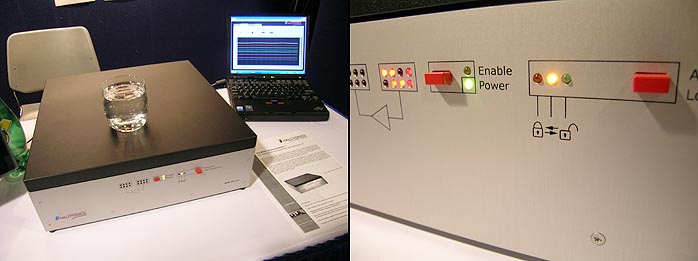 |
|||||||||
Most customized loudspeaker appearance of the show? Tetra's Manhattan Line 305s which showed in conjunction with Bluebird Music's new $19,685 Chord stack consisting of the new Chord One CD player [$5,995], the Prima preamp [$5,495], the Mezzo 150 amplifier [$6,495] and the matching Choral rack [$1,700]. True, that's still not chump change by any stretch but considering how that other Chord system in the room clocked in at $47,690 (combining the Blue transport with the DAC64, the CPA4000 pre and SPM4000 amp), this new baby Chord system played music in what for this firm are the el cheapo seats. I've requested a review loaner of the new CDP. |
|||||||||
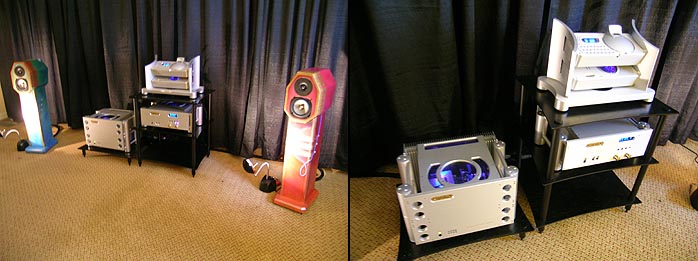 |
|||||||||
 |
|||||||||
Seeing a photo op when it tugs on my -- rolled-up -- shirt sleeves, I asked Bluebird's Jay Reina to line up with Tetra's Adrian Butts and Jonathan Scull of Scull Communications who nowadays shepherds certain audiophile companies through the querulous waters of public relations (his newest client is Moscode about which more later). I of course couldn't just have three middle-aged guys in my collage -- sorry Adrian -- so Nynke Laverman of the phenomenal Sielesâlt recording of Frisian Fado [Fama 198001] makes an appearance as well. It's a must-have for aficionados of our world music pages. Danke schön, Marja & Henk, for my original copy! |
|||||||||
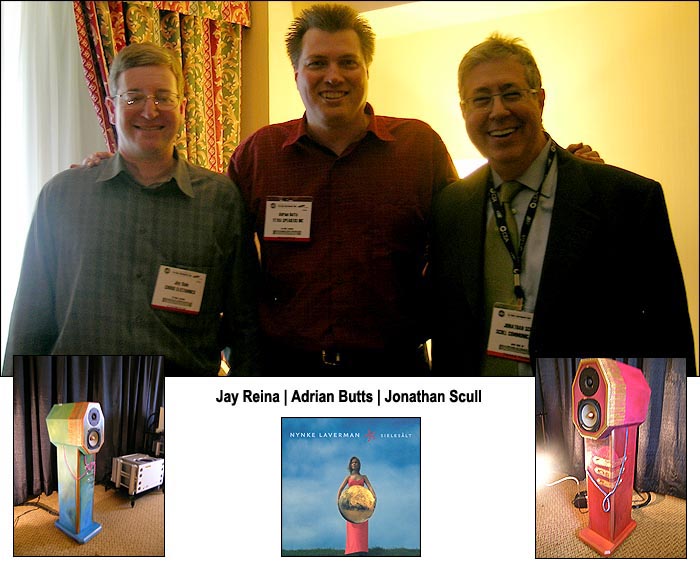 |
|||||||||
Onward ho now with our customary alphabetical coverage. Acapella and Einstein Audio, both imported and represented by Brian Ackerman of AAudio Imports, had the exhibitors on their knees -- literally -- to alternate between the big $26,000/pr LaCampanellas (already enroute to Arroyo Seco) and the diminutive down-ported Fidelio 2-ways [$6,800/pr with stands] which John Potis will review. Gussied up with IsoClean isolation transformer AC power, most attendees here thought that they were listening to the big 'uns when in fact the little guys were playing, leading Mr. Ackerman [right] to sell 5 pairs of Fidelios at the show - well, at least five was the count when last I visited this room. In fact, the LaCampanellas' 4 paralleled woofers literally flexed the room's walls once let loose, demonstrating again that too much speaker for the space -- any space -- is a solid recipe for disappointment in some form or another. Of course loudspeaker exhibitors always dream of showcasing their top offerings. Unless willing or able to pony up for the excessively costly ball rooms of the 2nd and 4th floors, they're stuck with small rooms unfit to let their flagships truly shine - a real conundrum. Not to be outdone by his importer, Volker Bohlmeyer of Einstein Audio nestled into the hotel's carpet as well. |
 |
||||||||
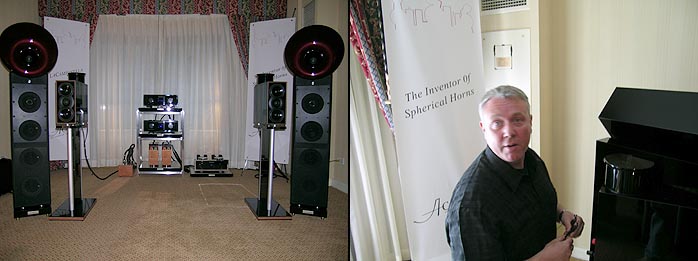 |
|||||||||
Always a friend of the slimmer wallets -- not many of those brothers and sisters to be found at HE 2005 -- Almarro from Japan showcased a new 6550-based integrated amplifier whose wooden controls will be metal in the final production version. Paul Candy, sworn to spend a leisurely summer of few reviews, just couldn't help himself and is scheduled to review both the floorstanding speakers and amp. Ditto for the new Hyperion monos and a full Odyssey Audio system. There goes your summer, Paul. Spotting the inverted Focal tweeter in the Almarro two-way with suspicion, we both had to admit that as implemented here, it didn't draw any attention to itself quite unlike elsewhere. Hmm. |
|||||||||
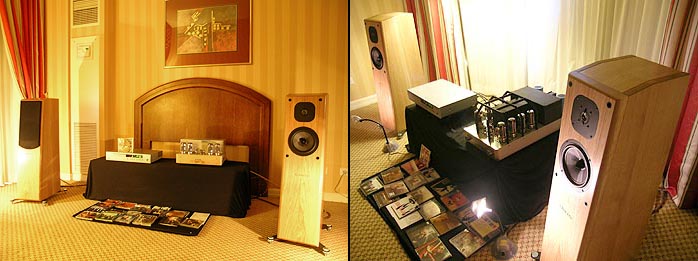 |
|||||||||
This Almarro room, as in years past, was again an oasis of sanity and comfort, presenting music in a non-audiophile fashion the average music lover can live with and afford. Ditto For Music Hall. Greek fisherman's cap off to both of them! |
|||||||||
 |
|||||||||
Analysis Audio Loudspeakers from Greece -- yes, there was a connection -- showed together with H2O Audio's M250 monoblocks in bi-amp mode. The Greek Apogees come in four flavors and sizes, starting with the $8,990/pr Omicron at 44" tall, moving on to the $10,990/pr Epsilon at 52", then the displayed $14,990/pr Omega (66" tall and 24" wide and 2.4" deep just as the smaller models) and lastly the $19,990/pr Amphitryon flagship that clocks in at 83" H x 28" W x 2.8" D. Brother Bill Cowen has a pair for review which is due shortly as is the well overdue Gill Audio Alana write-up. You see, the company Bill works for has recently built a new office in the Carolinas. This has turned his work week into 80 hours for the last two months. I'm sure our readers will appreciate the concomitant delay of handing in these reviews. |
|||||||||
 |
|||||||||
 |
|||||||||
| April Music from Korea decided on multi-channel with NHT in a small room which -- damn those reviewers -- had both Paul and I shy away. Think of their Stello line as the Arcam of the East and you've pegged its appearance, features and pricing. Anyone shopping these particular Arcam and Rotel leagues must put Stello by April Music on the same list. Ascendo Loudspeakers from Germany were teamed up with Ric Schultz of Virtual Dynamics cable fame with its in-line Neodymium magnets. Ex fighter pilot Darren Censullo of Avatar Acoustics [below in blue] hosted the loudspeaker brand he imports as well as Franck Tchang's Acoustic Systems wall-mounted resonance tuners. |
|||||||||
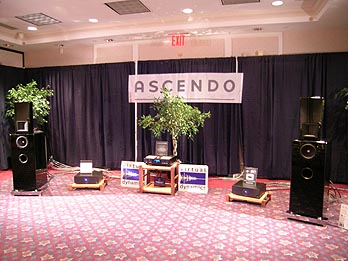 |
|||||||||
| Teaming up with the Kaiser in B&K, Steve Huntley of Great Northern Sound Company and Dennis Had of Cary, Ric Schultz introduced a hot-rodded Cary 302 player and a prototype pair of Luminance monoblocks dubbed "the world's fastest amplifiers" which were part of the display system. He'd also just discovered pureed smurfs, a wicked blue AVM paint compound with powerful resonance-absorptive properties. He and Darren promptly unbolted the drivers of the Ascendo System M-s speakers and Ric lavished brush after brush of expensive blue paint on their baskets and magnet structures. Unfortunately, I had happened upon this room too late to conduct any before/after comparison. Certain criticisms I had right after the treatment could have been due to the paint still drying and upsetting the equilibrium in the process. | |||||||||
 |
|||||||||
 |
|||||||||
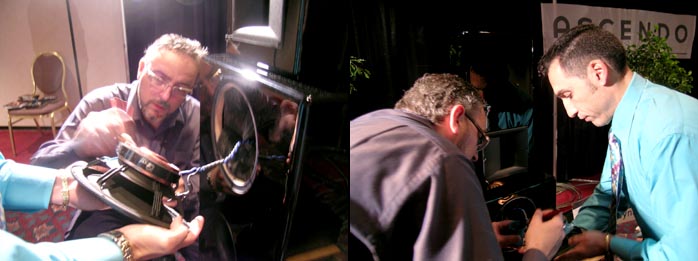 |
|||||||||
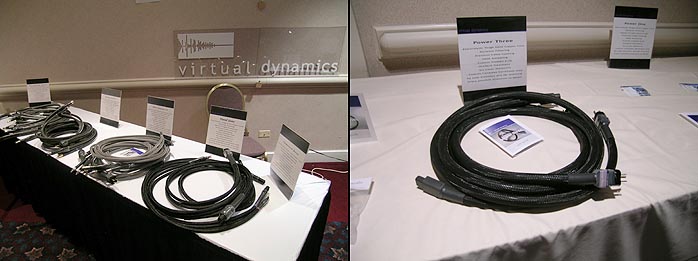 |
|||||||||
 |
|||||||||
 |
|||||||||
 |
|||||||||